Function Notation and How to Evaluate a Function
The common notation of a function is usually written as,

Don’t think of this too literally, that is, [latex]f[/latex] is being multiplied to [latex]x[/latex]. Instead, consider this as a mathematical expression which is read as

OR

Functions can also be written in different ways using other variables such as
- [latex]g(x)[/latex], [latex]h(x)[/latex], and [latex]k(x)[/latex]
In addition, functions may take other input values other than [latex]x[/latex].
- [latex]f(a)[/latex], [latex]h(r)[/latex], and [latex]k(m)[/latex]
The key idea is always to remember that the variable outside the parenthesis is the “name” of the function, while the variable inside the parenthesis is the input value of the function.
For instance, the following is called function [latex]k[/latex] with an input value of [latex]m[/latex].
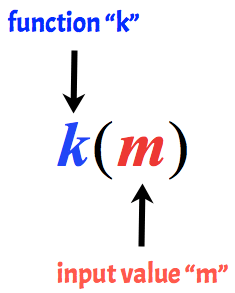
Basic Examples of Evaluating Functions
Example 1: Evaluate the function.

This is the normal notation of function where the function is [latex]f[/latex] while the input value is [latex]x[/latex]. To evaluate a function, what we want is to substitute every instance of [latex]x[/latex] in the expression and then simplify.
Since [latex]x = – 1[/latex] , we substitute this value in the function and simplify. In doing so, we get a solution that looks like this.
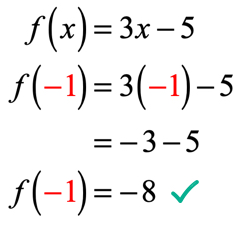
Example 2: Evaluate the function.

Observe that the function here is [latex]h[/latex] and the input value is [latex]k[/latex]. Just like in our previous example, we want to substitute whatever the numerical value assigned to [latex]k[/latex] into the given function, and simplify.
Since [latex]k = 3[/latex], your solution should look similar to this
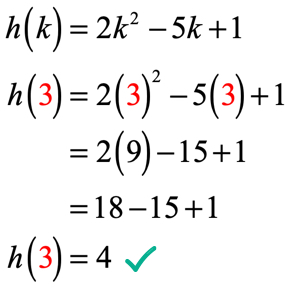
Example 3: Evaluate each value of [latex]x[/latex] in the table below using the function below. Plot the points in the [latex]xy[/latex]-axis and connect the dots to reveal the graph of the function.


Since there are seven [latex]x[/latex]-inputs, that means we will evaluate the function seven times as well. Try working this out on your own then come back to check your answers.
If you have done it correctly, these are the values:
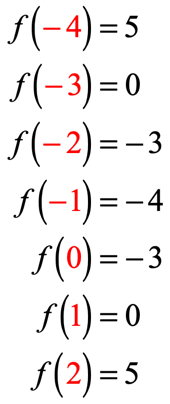
We can now place those output values in the table.

Think of the output values of the function [latex]f\left( x \right)[/latex] as the [latex]y[/latex]-values. This is how the graph looks like on the [latex]xy[/latex]-axis.
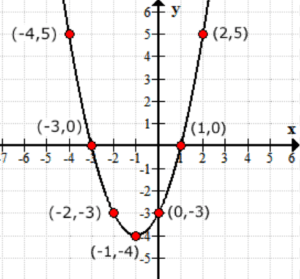
Intermediate Examples of Evaluating Functions
Example 4: Given that [latex]g\left( x \right) = {x^2} – 3x + 1[/latex], find [latex]g\left( {2x – 1} \right)[/latex].
In previous examples, we have been evaluating a function by a number. This time the input value is no longer a fixed numerical value, but instead an expression. It might look complicated but the procedure remains the same.
We will replace every instance of [latex]x[/latex] in [latex]g\left( x \right)[/latex] by the input value which is [latex]2x – 1[/latex]. Simplify by squaring the binomial, applying the distributive property, and combining like terms.
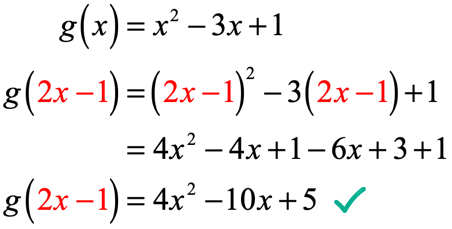
Example 5: Given that [latex]p\left( x \right) = {{4x – 1} \over x}[/latex] , evaluate [latex]p\left( 1 \right) – p\left( { – 1} \right)[/latex].
The problem may look intimidating at first, but once we analyze it and apply what we already know on how to evaluate functions, this shouldn’t be that bad!
What we need to do here is to evaluate the function at [latex]x = 1[/latex] then subtract by the value of the function when evaluated at [latex]x = – \,1[/latex].
Be very careful when you substitute the values and during the simplification process. If you are not careful in every step, it is very easy to commit mistakes when you add, subtract, multiply, or divide positive and negative numbers.
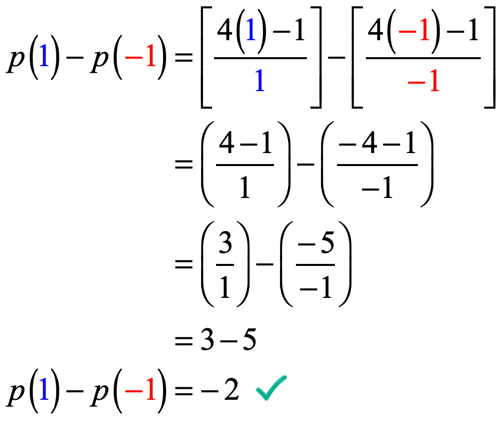
Advanced Example of Applying the Concept of Evaluating Functions
Example 6: If [latex]f\left( 2 \right) = 9[/latex], find the value of [latex]a[/latex] in the function below.

In the equation, [latex]f\left( 2 \right) = 9[/latex], we are told that if the input of the function is [latex]2[/latex]; the output of the function will be [latex]9[/latex]. Since the function is given to us, our first move is to at least substitute the value of [latex]2[/latex] and then simplify. This is what we’ll get.
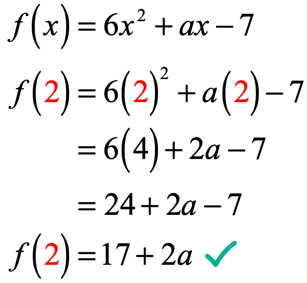
The output of the function after evaluating at [latex]x = 2[/latex] is [latex]17 + 2a[/latex]. Remember, we are also told that the output is [latex]9[/latex] using the given equation [latex]f\left( 2 \right) = 9[/latex]. Therefore what we need to do now is set them equal to each other, and solve the linear equation for the unknown value of [latex]a[/latex].
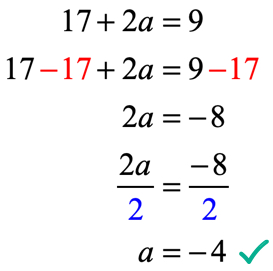
Let’s verify if the value of [latex]a = – \,4[/latex] in [latex]f(x) = 6{x^2} + ax – 7[/latex] can make the given condition [latex]f\left( 2 \right) = 9[/latex] to be a true statement.

It’s true! Hence, we have successfully solved the correct value of [latex]a[/latex].
